Rainbows are some of nature’s most remarkable and mesmerizing wonders. The color combinations and brilliance trigger feelings of calm, awe, and thankfulness to witness such a sight. If you stumble across a rainbow fish, you’ll react similarly to what happens when you see the rainbow.
So what is a rainbow fish, how many types are there, and why do they make excellent pets? And most importantly, how can you breed and care for them? We have all the answers and much more to share in this illuminating article.

What is a Rainbow Fish?
The scientific name for rainbow fish is Melanotaeniidae. This fish family is small, with the largest species barely reaching 8 inches in length. Nevertheless, their remarkable beauty compensates for what they lack in size. You see, rainbow fish are very colorful, bearing different hues like silver, blue, green, pink, red, and orange hues depending on the species.
Here’s what makes this fish genuinely fascinating: In the beginning, fingerlings are typically a plain silver-white color. Afterward, the hues get more vibrant the more they age. Wait, though; it gets even more enjoyable. Male rainbow fish are more colorful than females, like what you’ll notice with peacocks. And the color becomes brighter when they are trying to get the attention of the females.
The freshwater rainbow fish are omnivorous and will survive on crustaceans, insects, algae, and larvae. The rainbow fish is indigenous to Madagascar, Eastern and Northern Australia, New Guinea, and Indonesia.
Types of Rainbow Fish
There are over 50 identified species of rainbow fish. Consequently, you can have a range of choices if you breed them. Let’s look at some of the more popular rainbow fish below, shall we?
Forktail Rainbow Fish

With its iridescent fins, bright blue eyes, and cheerful disposition, these fish are sure to bring joy and life to any tank.
©iStock.com/Mirko_Rosenau
The Papua New Guinea native forktail rainbow fish or Pseudomugil furcatus is a tiny fish that measures about 2 inches in length. It has distinctive blue eyes and a forked tail. Besides these unique characteristics, the forktail rainbow fish has a vibrant coloration. The body is blue-green with bright red-orange fins and tails.
Their beauty makes them a popular choice for aquarium fish. It would be best to mimic the rainforest environment in your aquarium for them to thrive. These include temperatures between 75 to 80 degrees Fahrenheit and slight alkalinity of pH 7.0 and above.
The Red Irian Rainbow Fish

Female red Irian rainbow fish have a silver hue.
©Gonzalo Jara/Shutterstock.com
The New Guinea native red Irian rainbow fish has a nose-to-tail red coloring, at least for the males. In contrast, the females have a silver hue. The association is usually a fiery temper or disposition when you see red. Yet, this would not be further from the truth with this gentle, non-assuming fish.
Also, going by the scientific name Glossolepis incisus, the fish can grow to about 6 inches long. They are active and will need sufficient space to move around. So your aquarium should be able to hold at least 50 gallons of water. Ensure you maintain temperatures of 72 to 79 degrees Fahrenheit and a pH of 7-8.
The predatory fish is delicate and will not do well in poor weather conditions. Thus, you must keep up with cleaning the aquarium and ensuring optimal conditions for its survival.
Axelrod’s Rainbow Fish
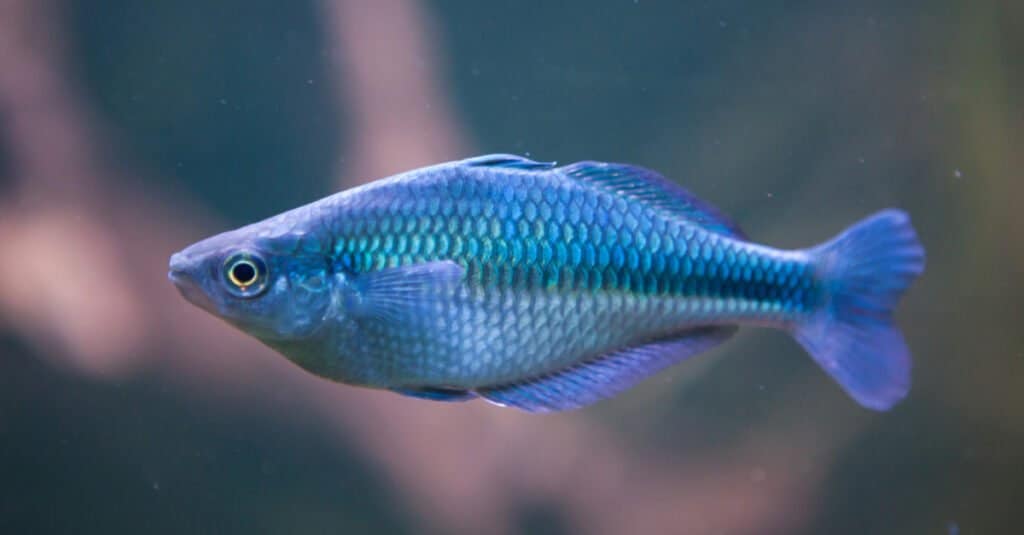
Axelrod’s rainbowfish is easy to identify due to its silver-blue body.
©Vladimir Wrangel/Shutterstock.com
Melanotaenia herbertaxelrodi, or Axelrod’s rainbow fish, is another New Guinea rainbow fish. The evenly-tempered fish is easy to care for, making it quite popular with aquarium lovers.
Axelrod’s rainbowfish is easy to identify due to its silver-blue body with bright red-orange stripes making horizontal streaks across the midsection.
The optimal aquarium environment for the omnivorous axelrod’s rainbow fish is a pH range of 7 to 8 and temperatures of 72 to 78 degrees Fahrenheit.
Red Neon Rainbow Fish
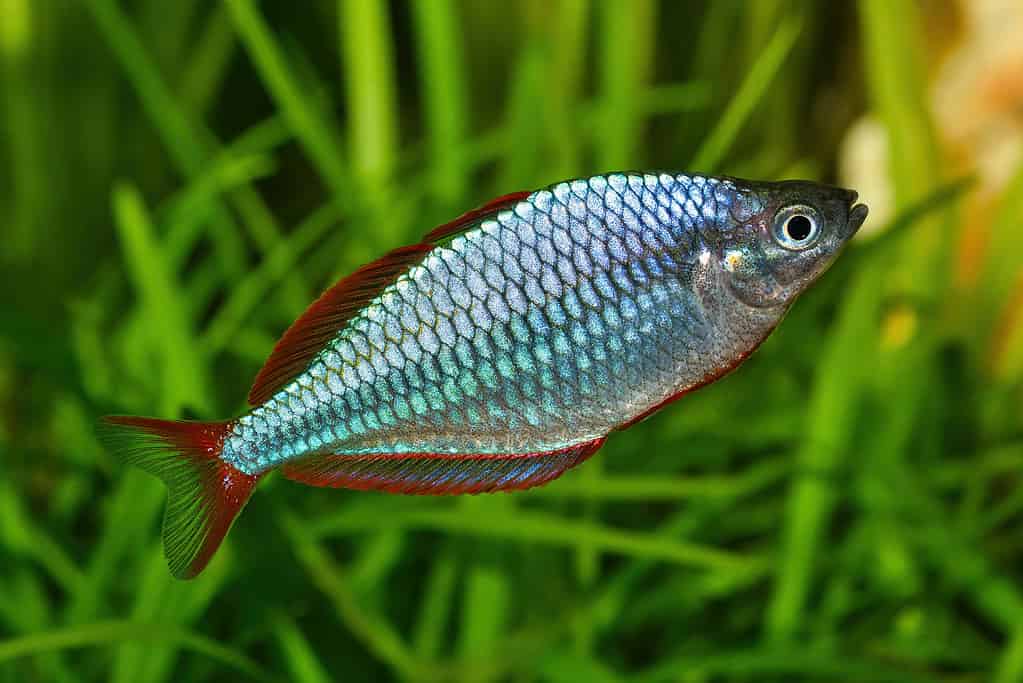
This vibrant red neon rainbow fish is ready to explore the depths of its aquamarine world.
©iStock.com/NERYX
The red neon rainbow fish will add a pop of color to your aquarium due to its vibrant neon red and blue coloration. Also, going by the name Melanotaenia praecox, the fish is native to Indonesia and Papua.
The 1.5-inch red neon fish is peaceful and lives well with other non-aggressive species. Being omnivorous, these beautiful fish will eat various foods, making them relatively easy to care for. Please ensure you maintain a pH range of 7 to 8 and temperatures of 72 to 78 degrees Fahrenheit.
Boesemani Rainbow Fish
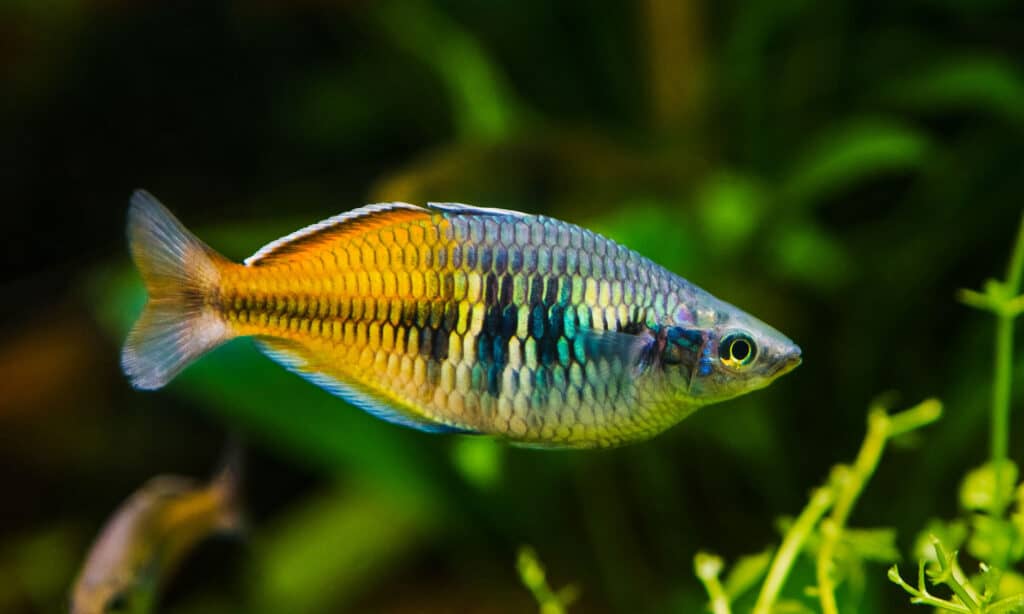
This beautiful boesemani rainbow is captivating to watch as it swims around its tank filled with lush, green plants. It’s truly a sight to behold.
©Aleron Val/Shutterstock.com
The boesemani or Melanotaenia boesemani rainbow fish has an almond shape and can grow to about 4 inches. The Indonesian native has a unique bi-colored body featuring a shiny blue top and an orange lower half. Together with this is a yellow stripe down the midsection giving it a unique look. These colors are incredibly vivid in males.
The ideal aquarium conditions are a water pH of 7 to 8 and a temperature of 75 to 82 degrees Fahrenheit. Please ensure that there is plenty of space for them to swim around. Thus aim for a four-foot or longer aquarium. The omnivorous boesemani is easy to care for and can live up to five years with proper care.
Crimson Spotted Rainbow Fish

This beautiful crimson-spotted rainbow fish is sure to brighten up any aquarium.
©iStock.com/Mirko_Rosenau
The Australian-native crimson spotted rainbow fish also goes by Melanotaenia duboulayi. The bright crimson spots against a metallic blue-green backdrop make the fish easy to identify. A fully grown adult can grow to about 5 inches.
When breeding, please keep the crimson spotted rainbow fish separate from aggressive species because of their calm temperament. The ideal aquarium conditions are a pH of 7 to 8 and temperatures of 72 to 79 degrees Fahrenheit.
The crimson spotted rainbow fish are omnivorous and require plenty of space to swim around. In terms of care, they’re more demanding. Finally, keep up with ensuring consistent water flow and plenty of oxygen. The water quality must always remain optimal, so keep up with water changes to ensure they thrive.
Celebes Rainbow Fish

Found in highland streams of Sulawesi, Indonesia, the celebes rainbow fish is a beautiful and colorful addition to any aquarium.
©Al Carrera/Shutterstock.com
The freshwater celebes rainbow fish or Marosatherina ladigesi’s original home is Indonesia’s Lake Poso basin and Malili lakes.
The celebes rainbow fish is striking due to its silvery blue body and distinctive black stripe down its midsection. The tail and dorsal fins have splashes of yellow and black patterns, further adding to the visual beauty.
The even-tempered celebes rainbow fish can grow to about 3 inches. They are active and will need plenty of space to move around. As a result, please ensure their aquarium can hold more than 20 gallons of water. Ideal aquarium conditions are a pH of 7 to 8 and temperatures ranging from 75 to 82 degrees.
Keep the aquarium environment steady because the fish do not react well to sudden environmental changes. Stock up on many omnivorous foods like vegetable matter, flakes, pellets, and live foods.
The Threadfin Rainbow Fish
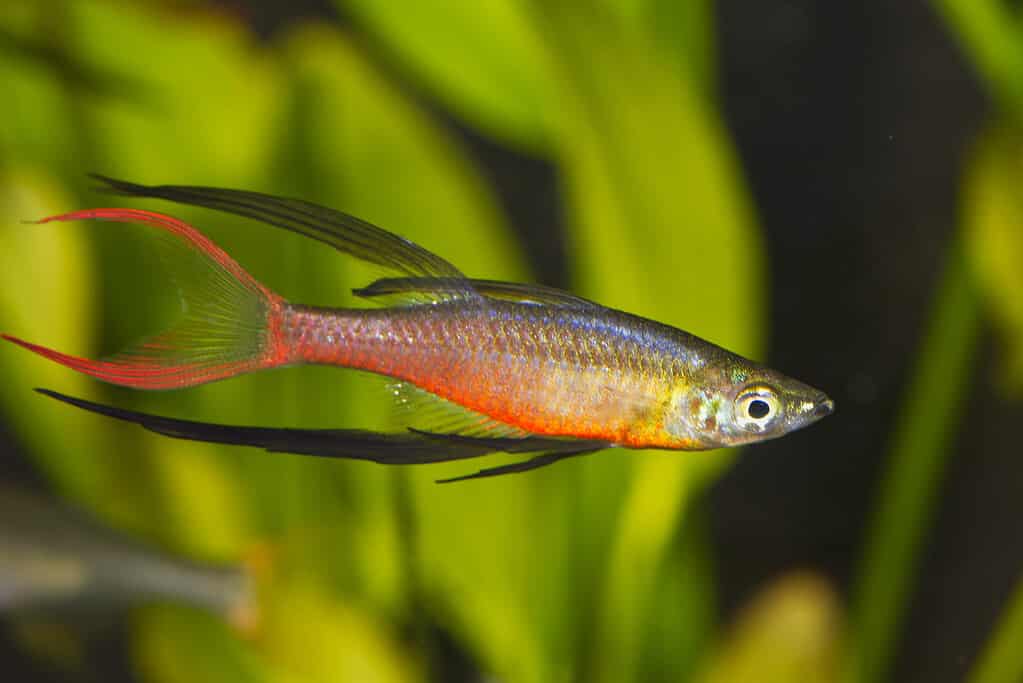
The threadfin rainbowfish is an iconic species of tropical fish that dazzles with its iridescent blues and purples.
©iStock.com/NERYX
The threadfin or Iriatherina Werneri rainbow fish comes from Australia and New Guinea. When you look at a threadfin rainbow fish, it appears delicate due to its slender, elongated body. The pale and transparent blue coloration further adds to its sheer beauty.
At only 2 inches long, their long thread-like extensions, from which the name originates, are also striking. As is typical with this fish species, the males have more color and longer fins.
Ideal aquarium conditions are a pH of 7 to 8 and temperatures ranging from 75 to 82 degrees. As omnivores, their diet is flexible, making them easy to care for.
Selecting, Breeding and Caring for Rainbow Fish: A Guide
Rainbow fish will make a beautiful addition to your aquarium. But to ensure you get to enjoy them for a long time lies in how well you take care of them. From the fish species we have shared above, it’s clear that there are some things you need to get right. These include ensuring optimum aquarium conditions and stocking up on the right foods.
You must also maintain proper water flow and oxygen conditions in the tanks. But get ready for some handy tips, as there’s much more you need to be aware of.
Selecting Rainbow Fish
Take note of the following considerations when selecting rainbow fish for breeding purposes:
Species
The rainbow fish comes in various species, as we shared above. Finding one that you’ll fall in love with won’t be an issue. Because each rainbow fish species has unique characteristics, it would help if you did proper research on the breeds. Please take note of factors like their preferred habitats, water conditions, and breeding patterns.
Another critical consideration when choosing the species is the difficulty level of caring for them. Fortunately, most rainbow fish are hardy and adapt well to most environments. However, some may require more maintenance than others.
The Health of the Fish
Before shopping for your rainbow fish, learn how to identify healthy ones. Check whether the fish is active and alert, as lethargy may indicate a sick or stressed fish. Furthermore, another critical indicator of health is the vibrancy of the colors. Dull colors may signify disease or ill health.
If adding new fish to a tank or aquarium, keep them in a separate area for several weeks first. This ensures you do not introduce any diseases the fish could carry to the other ones.
Maturity of the Fish
The breeding age for rainbow fish can be anywhere from six to 12 months, depending on the species. Hence, err on caution by getting one at least a year old, signifying that it has reached maturity.
Gender
The size of the tank or aquarium will determine the male-to-female ratio. Too many males can lead to aggression in smaller settings due to fighting for the females. The rainbow fish species also matters. Take the example of the boesemani rainbow fish. The males are very aggressive, so you can only have a few in one tank. We go back to the earlier point of doing proper research on the species so that you have clarity on their behavior.

Brighten up your day with the stunningly beautiful rainbow darter –
Etheostoma caeruleum. This vibrant fish will captivate you with its dazzling colors.
©Jeff Finley, USFWS, Public domain, via Wikimedia Commons – License
Ideal Habitat for Rainbow Fish
The home you create for the rainbow fish will significantly impact their survival and breeding. With that in mind, please take note of the following factors:
Size of the Habitat
Rainbow fish are energetic, and most require plenty of space to move around. A crucial determinant when choosing the habitat size is how big the fish can get. Naturally, rainbow fish do not grow very big, but a ten-gallon tank is inadequate for more prominent species like the boesemani. Yet, it would do quite well for the smaller threadfin rainbow fish.
Water Health
Ensure optimal conditions at all times in the habitat so that you mimic, as best as you can, the natural conditions the fish live in. Consequently, that means:
- Proper filtration.
- Good water flow with sufficient circulation.
- Adequate oxygen levels.
- Stable pH, depending on the species.
- The right water temperature must never fluctuate to more than +/-2 degrees.
- Plants, rocks, and other aquarium decorations provide hiding places.
- Plenty of room for the fish to swim around.
A guide to taking care of the habitat includes:
- Daily filter and water temperature checks.
- Weekly water quality checks.
- Monthly filter and water changes of approximately 10 to 25% of the total volume.
Rainbow Fish Diet
Many rainbow fish are omnivorous, so you must stock up on pellets, flakes, frozen, dried, and live food. Simultaneously, ensure plenty of variety to give the fish plenty of nutrition.
Signs of Disease in the Fish
Be alert for any of the following signs because they may indicate sickness in the fish. Unquestionably, taking care of such things soon enough is critical to avoid spreading the disease to others.
- Loss of appetite and colorless
- Signs of fungi in the mouth or body
- Discolored or frayed fins
- Bloating
- Lethargic or very erratic movements
- Difficulty breathing
- Elevated scales
- Popping or cloudy eyes
You may need to call in a vet or speak to a fish specialist. Some conditions, like fungus, may be due to poor water conditions. Taking steps to improve water quality may clear it up.
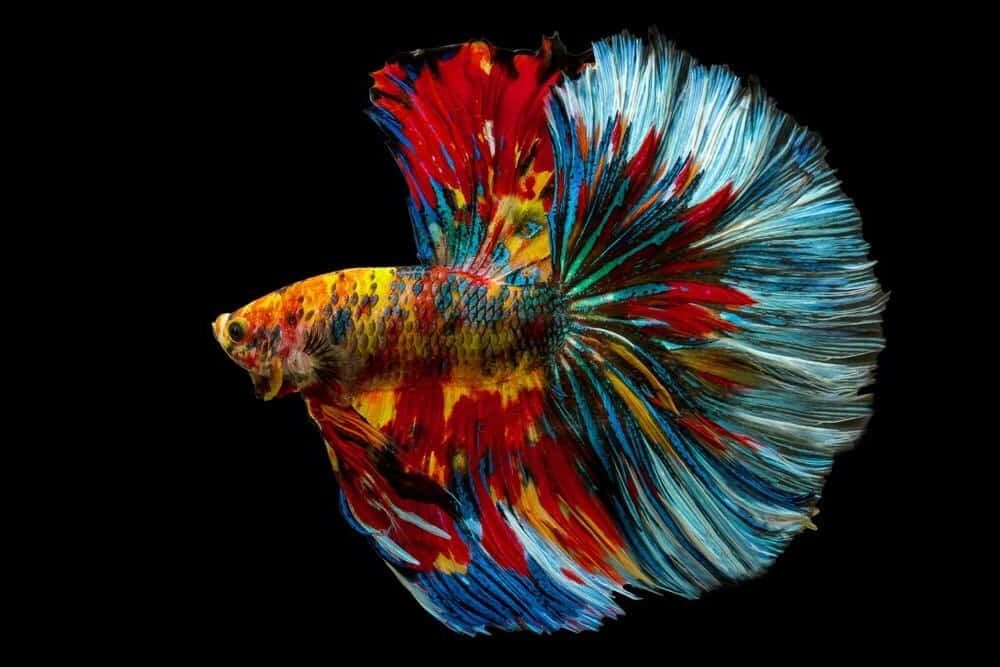
The Betta splendens (Siamese fighting fish) is truly mesmerizing to watch as it gracefully glides through the water. So graceful, yet so fierce.
©Mr. Witoon Boonchoo/Shutterstock.com
Breeding Rainbow Fish
Depending on the species, rainbow fish will reach breeding age at about six months. There are some steps or conditions that you must create for successful breeding.
Environment
An ideal environment is critical for the rainbow fish to breed. The aquarium or tank should be clean and have good quality water with proper water and oxygen flow. Also, provide the fish plenty of hiding places to lay eggs in peace.
Pairing of Fish
Healthy male and female pairing is critical for breeding purposes. Like any other animal species, it helps to avoid inbreeding. So ensure you get different genetic lines for healthy offspring.
Provide Spawning Mops or Breeding Cones
Spawning mops or breeding cones will provide a surface for the rainbow fish to lay their eggs.
Knowing when a female rainbow fish is ready to spawn is easy. You only need to observe the males’ behavior during this time. They will chase the female around, and at this time, their color vibrancy is outstanding as they hope to get the attention of the females.
The eggs will hatch anywhere from 2 to 7 days, depending on the environment and the tank or aquarium. It’s a good idea to separate the fingerlings by taking them to another tank once they can free-swim. Feed them everyday foods but in small amounts.
Bring Color and Vibrancy to Your Aquarium with Rainbow Fish
Rainbow fish are delightful creatures due to their outstanding beauty, energy, and vibrancy. It could explain why this makes them so popular with fish or aquarium lovers. Therefore, go ahead and get yourself some rainbow fish. Finally, the one thing you must do is teach yourself everything you can about them with in-depth research.
Summary of 8 Types of Rainbow Fish
| Number | Type of Rainbow Fish |
|---|---|
| 1 | Forktail Rainbow Fish |
| 2 | The Red Irian Rainbow Fish |
| 3 | Axelrod’s Rainbow Fish |
| 4 | Red Neon Rainbow Fish |
| 5 | Boesemani Rainbow Fish |
| 6 | Crimson Spotted Rainbow Fish |
| 7 | Celebes Rainbow Fish |
| 8 | The Threadfin Rainbow Fish |
The photo featured at the top of this post is © iStock.com/vojce
Thank you for reading! Have some feedback for us? Contact the AZ Animals editorial team.






